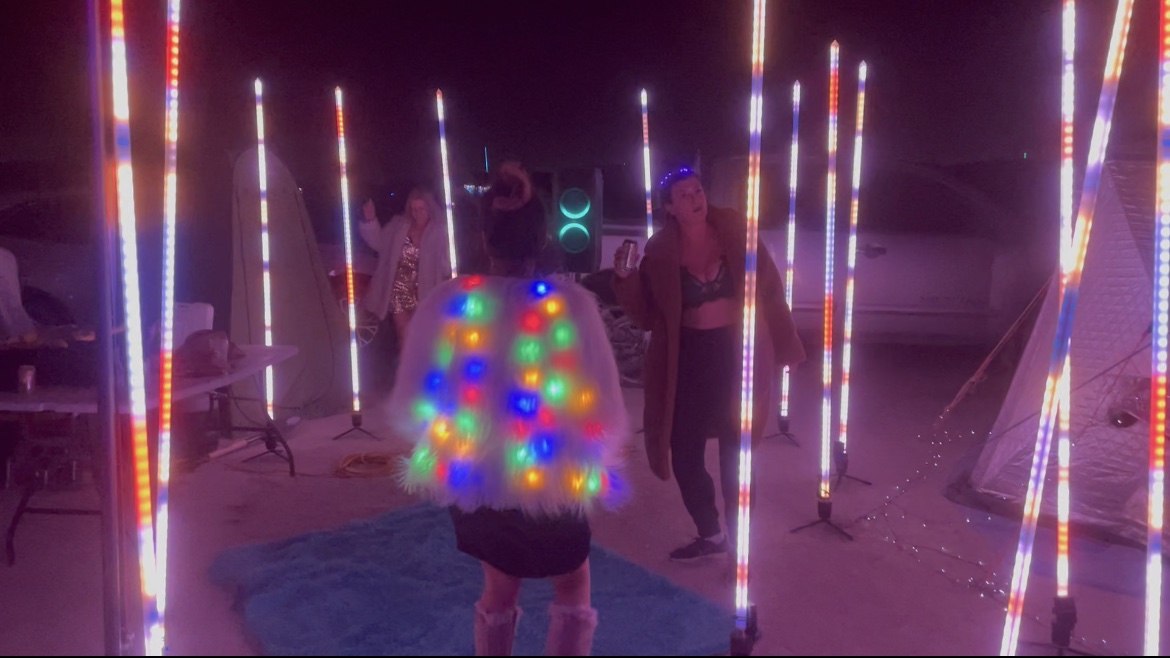These portable LED light poles make pretty lights for a dance party - and better yet:
They're portable! Convenient tripod bases keep them standing at attention, and a 10Ah USB battery (like the one you charge your phone with) will power them for about 8 hours.
They're versatile! You can deploy them in a wide open space at Burning Man, in a private event space, or right next to each other in your living room. (Click into these links for videos of them in action.)
They're coordinated! If you put them next to each other, they sync using near-field radio. And they'll even daisy-chain, meaning the furthest ones can be really far apart as long as there are some in the middle to relay the signal.
They're sturdy! I built 20 of them and deployed them at parties in all kinds of weather, from hot & dusty windstorms to torrential rain. They've been tossed in a truck, carried around as totems, knocked or blown over, and almost all of 'em are still working. Just don't let people use them like light sabers (lesson learned.)
They're also in progress with lots of things that could be improved. But for now:
- they play patterns from an expanding set of "genetically-driven" combinations
- they stay in sync or deliberately drift from each other in pleasing ways
- they operate internally at a certain BPM - allowing them to sync to music
Each light tube is running custom software on a Teensy LC (Arduino-compatible) microcontroller. The software is running a generative light program that has a simple "DNA" specifying its pattern, color, effects overlay, offset, and so on.
The patterns run on a clock that's synced to a specific BPM and counts out the 4/4 rhythm of most dance music, so they morph and change on individual beats, measures, and phrases. After several beat phrases pass, a pole's DNA is mutated a little, which can cause it to change color, or adopt a new pattern, etc.
An on-board NRF radio lets a light pole broadcast its DNA and clock timer; when others hear the signal, they can choose to follow along by updating their own pattern DNA to match it. The method of coordination is pretty simple right now: each pole has an 8-bit ID, and lower-ID poles obey higher-ID poles.
If they're all close enough, they'll soon start doing the same thing as a group and keeping their clock timers in sync. In case they're not close enough, poles also re-broadcast all the signals they receive and obey. This lets them pass along a signal through the group until all of them have found it.
Some randomness and chaos is intentional. Radio isn't 100% reliable, so they sometimes fall out of contact and then re-connect. And in some cases, the poles will deliberately offset their own clock a bit so that they are clearly doing the same thing but not exactly at the same time. Each tube is actually running several copies of the software and smoothly "cross-fading" between them, to avoid any jarring transitions.
They're not for sale, but check out the build instructions in this directory, complete with a parts list & assembly instructions. I'd love it if you build your own!
The form factor was inspired by Mark Lottor's Hexatron. The color schemes were inspired by the work of Christopher Schardt and many were found on cpt-city. The code was written using FastLED and most patterns are evolved versions of FastLED examples. It's based on Chuck Sommerville's led-swarm, and still follows its theory for radio connection. I used Paul Stoffregen's WS2812Serial for smooth animation, and of course his Teensy CPU made the whole thing possible. Standing on the shoulders of these giants let me create these in about a month, in time to debut at Burning Man 2019 and appear at many parties since!
